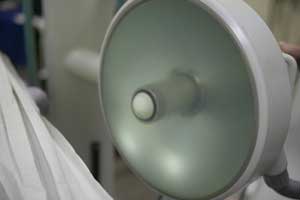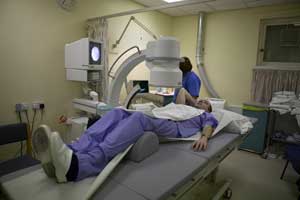|
|||||||||||||||||||||||||||||||||||||||||||||||||||||||
|
Stones Renal stones are painful. In fact women who have had babies and stones always say they would rather have another baby than another kidney stone! So where is this pain felt? Classically it is felt from the affected kidney in a strip down toward the groin. The further the stone has passed down the water pipe (or ureter) the closer to the groin the pain is felt. Most small stones (less than 5mm) will pass spontaneously, all that is needed is time and pain killers, larger stones or stones complicated by infection need treatment, in the latter case urgent treatment. How are stones treated? This depends on the position and size of the kidney stone. Medium sized stones (1-2cm) in the kidney are often treated with ESWL or extra-corporeal shock wave lithotripsy. This fires energy, akin to sound energy into a point focused at the kidney stone, each session lasts 30 minutes to 1 hour and is usually repeated two or three times.
The lithotripsy head containing energy the ultrasound energy source
A patient having treatment in the lithotripsy room
A close up of the position of the lithotriptor Larger stones can cause a blockage in the ureter if the fragments jam the pipe after being broken. To avoid this a tube known as a JJ or double J stent can be used. These stents have side effects of their own which are discussed to the right. Large stones (2cm or greater) in the kidney are usually treated with a telescopic procedure called a PERC this is short for a percutaeneous nephrolithotomy. A telescope is inserted into the kidney under anaesthesia and the stone is broken down with ultrasound. The patient is usually in hospital for 3 or 4 days. Small stones in the water pipe or ureter are often treated with a laser. A tiny telescope is passed up the ureter under general anaesthesia and the stone is blasted with the laser. Surgeons often use a JJ stent after this procedure. See the operations section for more information Stones are difficult to treat because they are unpredictable, a growth in the kidney is always treated with removal but stones can move during the course of a procedure or be impossible to get to. Have some patience with your surgeon, stones are so unpredictable that the treatment of stones has its own acronym BAWS, which stands for b****ring around with stones. Avoiding Stones There are several metabolic causes for stone disease which can be treated with specific drugs but in the main, fluid intake is the key preventative factor. Stones form in concentrated, darkly coloured urine, often during the summer or on holiday. The more dilute the urine is the less likely stones are to form, the aim is to have pale straw coloured urine at all times. Anyone who has a stone has a 50% chance of developing another within 10 years drinking plenty of fluid is the best way to avoid the pain of passing a stones. |
Double J stents Double J stents are small tubes which pass from the kidney to the bladder They are called JJ stents because the top and bottom have a curled end to prevent migration of the stent Stents irritate the bladder and make the patient feel as if the need to pass water more often They also stop the normal one way valve at the base of the bladder, urine therefore passes up to the kidney when the patient passes water, this is felt as an ache during passing water At the end of passing water an odd sensation is usually felt in the lower abdomen Stents are removed under local anaesthetic with a small telescope. The procedure is not painful but does make you feel as if you are passing water, allot. Stones can form on the end of stents if they are left in the body too long. Make sure your stent is removed before its been in for 6 months.
|
||||||||||||||||||||||||||||||||||||||||||||||||||||||
|
|
|||||||||||||||||||||||||||||||||||||||||||||||||||||||



